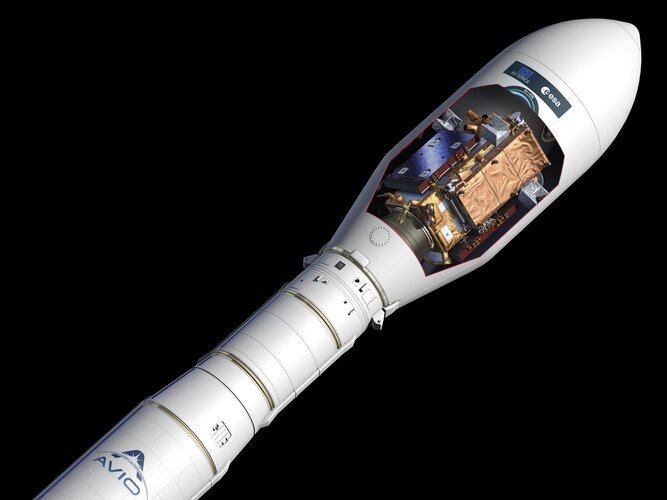Farnborough International Space Show: A nexus for global space innovation
Tuesday, 19 November 2024 13:58

Exotrail’s geostationary spacevan to launch on Ariane 6 in 2026
Tuesday, 19 November 2024 13:47

Mike Greenley, MDA Space – Commercial Space Transformers
Tuesday, 19 November 2024 12:34

Researchers study the roar of SpaceX's Starship and its impact on communities and the environment
Tuesday, 19 November 2024 11:38This request seems a bit unusual, so we need to confirm that you're human. Please press and hold the button until it turns completely green. Thank you for your cooperation!
Press and hold the button
If you believe this is an error, please contact our support team.
185.132.36.159 : c042a820-e66b-452f-adf5-b0facdba
Space for Shore: Sentinel-1 reveals Arctic glacier retreat
Tuesday, 19 November 2024 11:37
As Arctic temperatures rise, marine-terminating glaciers—especially in places like Svalbard—are undergoing rapid retreat and intensified calving.
The ESA-funded Space for Shore project utilises radar data from the Copernicus Sentinel-1 mission to provide precise, year-over-year insights into glacier retreat and calving intensity, particularly in areas like Kongsfjorden, where notable glaciers are experiencing significant retreat.
Artist impression of Sentinel-1C in the Vega-C launcher
Tuesday, 19 November 2024 09:08 Image:
Artist impression of Sentinel-1C in the Vega-C launcher
Image:
Artist impression of Sentinel-1C in the Vega-C launcher SpaceX set for Starship's next flight, Trump expected to attend
Tuesday, 19 November 2024 09:06 SpaceX is poised for its next Starship megarocket test flight on Tuesday, with US President-elect Donald Trump expected to witness the second ever attempt to catch its descending booster stage in the launch tower's "chopstick" arms.
It comes just over a month after the company first pulled off the technical tour de force that underscored its position as the world leader in reusable rocketry.
SpaceX is poised for its next Starship megarocket test flight on Tuesday, with US President-elect Donald Trump expected to witness the second ever attempt to catch its descending booster stage in the launch tower's "chopstick" arms.
It comes just over a month after the company first pulled off the technical tour de force that underscored its position as the world leader in reusable rocketry. Can the Trump-Musk 'bromance' last?
Tuesday, 19 November 2024 09:06 The world's richest man, Elon Musk, has been an ever-present sidekick for President-elect Donald Trump since the US election at the start of the month.
"I can't get him out of here," Trump joked about Musk at his Mar-a-Lago resort in Florida last Thursday. "I like having him here as well. He's done a fantastic job, an incredible mind."
But can the bromance between the world's wealthiest
The world's richest man, Elon Musk, has been an ever-present sidekick for President-elect Donald Trump since the US election at the start of the month.
"I can't get him out of here," Trump joked about Musk at his Mar-a-Lago resort in Florida last Thursday. "I like having him here as well. He's done a fantastic job, an incredible mind."
But can the bromance between the world's wealthiest Living microbes identified in Earth's driest desert using new technique
Tuesday, 19 November 2024 09:06 The Atacama Desert in Chile, known as the world's driest location, presents a harsh environment for life due to its extreme aridity. Despite this, research has discovered thriving microbial communities within its sandy soil. Investigating the functionality of microorganisms in such an environment has been challenging because it's hard to distinguish between genetic material from living and decea
The Atacama Desert in Chile, known as the world's driest location, presents a harsh environment for life due to its extreme aridity. Despite this, research has discovered thriving microbial communities within its sandy soil. Investigating the functionality of microorganisms in such an environment has been challenging because it's hard to distinguish between genetic material from living and decea Space Systems Command concludes Tetra-1 satellite mission
Tuesday, 19 November 2024 09:06 Since its launch on November 1, 2022, the U.S. Space Force's Space Systems Command (SSC), in collaboration with Millennium Space Systems, a Boeing Company, has successfully wrapped up the Tetra-1 mission.
Tetra-1 marked the first in a series of small satellites designed to showcase how SSC collaborates with non-traditional vendors to enhance on-orbit capabilities for the Space Force. Part
Since its launch on November 1, 2022, the U.S. Space Force's Space Systems Command (SSC), in collaboration with Millennium Space Systems, a Boeing Company, has successfully wrapped up the Tetra-1 mission.
Tetra-1 marked the first in a series of small satellites designed to showcase how SSC collaborates with non-traditional vendors to enhance on-orbit capabilities for the Space Force. Part Think fast: A missile-defense system built for speed
Tuesday, 19 November 2024 09:06 Satellites positioned high above Earth transmit crucial data to the surface in under a second, appearing swiftly on a computer screen monitored by a U.S. Space Force operator. The operator's swift understanding of this data is vital for rapid decision-making during high-stakes missile defense situations.
"Speed is everything. Speed to mission, speed to impact, speed to performance," said J
Satellites positioned high above Earth transmit crucial data to the surface in under a second, appearing swiftly on a computer screen monitored by a U.S. Space Force operator. The operator's swift understanding of this data is vital for rapid decision-making during high-stakes missile defense situations.
"Speed is everything. Speed to mission, speed to impact, speed to performance," said J 






